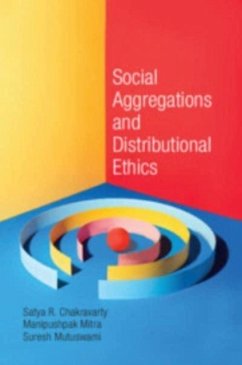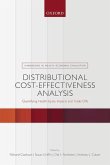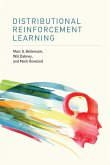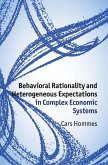Satya R. Chakravarty (Calcutta Indian Statistical Institute), Manipushpak Mitra (Calcutta Indian Statistical Institute), Suresh Mutuswami (University of Leicester)
Social Aggregations and Distributional Ethics
Satya R. Chakravarty (Calcutta Indian Statistical Institute), Manipushpak Mitra (Calcutta Indian Statistical Institute), Suresh Mutuswami (University of Leicester)
Social Aggregations and Distributional Ethics
- Broschiertes Buch
- Merkliste
- Auf die Merkliste
- Bewerten Bewerten
- Teilen
- Produkt teilen
- Produkterinnerung
- Produkterinnerung
The subject of this textbook is social choice theory and welfare economics. In addition to covering the well-known areas of the subject, it includes new issues like welfare evaluation under uncertainty, and inequality. Its easy exposition along with graphical and numerical illustrations of the concepts makes it a useful text.
Andere Kunden interessierten sich auch für
![Distributional Cost-Effectiveness Analysis Distributional Cost-Effectiveness Analysis]() Distributional Cost-Effectiveness Analysis67,99 €
Distributional Cost-Effectiveness Analysis67,99 €![Self-Insight Self-Insight]() David DunningSelf-Insight79,99 €
David DunningSelf-Insight79,99 €![The Politics of Central American Integration The Politics of Central American Integration]() Rafael A. Sanchez SanchezThe Politics of Central American Integration63,99 €
Rafael A. Sanchez SanchezThe Politics of Central American Integration63,99 €![Distributional Justice Distributional Justice]() Hilde BojerDistributional Justice68,99 €
Hilde BojerDistributional Justice68,99 €![Functional Analysis for Physics and Engineering Functional Analysis for Physics and Engineering]() Hiroyuki Shima (Japan University of Yamanashi)Functional Analysis for Physics and Engineering66,99 €
Hiroyuki Shima (Japan University of Yamanashi)Functional Analysis for Physics and Engineering66,99 €![Distributional Reinforcement Learning Distributional Reinforcement Learning]() Marc G. BellemareDistributional Reinforcement Learning69,99 €
Marc G. BellemareDistributional Reinforcement Learning69,99 €![Behavioral Rationality and Heterogeneous Expectations in Complex Economic Systems Behavioral Rationality and Heterogeneous Expectations in Complex Economic Systems]() Cars Hommes (Universiteit van Amsterdam)Behavioral Rationality and Heterogeneous Expectations in Complex Economic Systems50,99 €
Cars Hommes (Universiteit van Amsterdam)Behavioral Rationality and Heterogeneous Expectations in Complex Economic Systems50,99 €-
-
-
The subject of this textbook is social choice theory and welfare economics. In addition to covering the well-known areas of the subject, it includes new issues like welfare evaluation under uncertainty, and inequality. Its easy exposition along with graphical and numerical illustrations of the concepts makes it a useful text.
Hinweis: Dieser Artikel kann nur an eine deutsche Lieferadresse ausgeliefert werden.
Hinweis: Dieser Artikel kann nur an eine deutsche Lieferadresse ausgeliefert werden.
Produktdetails
- Produktdetails
- Verlag: Cambridge University Press
- Seitenzahl: 276
- Erscheinungstermin: 11. Mai 2023
- Englisch
- Abmessung: 229mm x 152mm x 16mm
- Gewicht: 358g
- ISBN-13: 9781108927635
- ISBN-10: 1108927637
- Artikelnr.: 62951413
- Herstellerkennzeichnung
- Libri GmbH
- Europaallee 1
- 36244 Bad Hersfeld
- gpsr@libri.de
- Verlag: Cambridge University Press
- Seitenzahl: 276
- Erscheinungstermin: 11. Mai 2023
- Englisch
- Abmessung: 229mm x 152mm x 16mm
- Gewicht: 358g
- ISBN-13: 9781108927635
- ISBN-10: 1108927637
- Artikelnr.: 62951413
- Herstellerkennzeichnung
- Libri GmbH
- Europaallee 1
- 36244 Bad Hersfeld
- gpsr@libri.de
Satya R. Chakravarty is Professor of Economics at the Indian Statistical Institute, Calcutta. He is a renowned name in the field of studies of Game Theory and Social Choice and has published widely, both books and in reputed journals. He authored 'A Course on Cooperative Game Theory' with Manipushpak Mitra that was published by the Press in 2015.
Preface
1. Introduction
Bibliography
2. Individual and social orderings
2.1. Introduction
2.2. relations
2.3. Preference relations and choice sets
2.4. Social orderings, quasi-orderings and weak quasi-orderings
2.5. Exercises
2.6. Bibliographical notes
bibliography
3. May's theorem
3.1. Introduction
3.2. The framework
3.3. May's theorem
3.4. Robustness of the axioms
3.5. Exercises
3.6. Bibliographical notes
Bibliography
4. Arrow's theorem with individual preferences
4.1. Introduction
4.2. The framework
4.3. The Arrow Impossibility theorem
4.4. Two proofs of Arrow's theorem
4.5. Exercises
4.6. Bibliographical notes
Bibliography
5. Relaxing Arrow's axioms
5.1. Introduction
5.2. Relaxing Weak Pareto
5.3. Relaxing transitivity of (Social) binary relations
5.4. Domain restriction: single peaked preferences
5.5. Exercises
5.6. Bibliographical notes
Bibliography
6. Arrow's theorem with utilities
6.1. Introduction
6.2. The framework and assumptions
6.3. Measurability and comparability
6.4. Arrow's theorem
6.5. Positional dictatorships
6.6. Leximin
6.7. Utilitarianism
6.8. Exercises
6.9. Bibliographical notes
Bibliography
7. Harsanyi's Social Aggregation theorem
7.1. Introduction
7.2. The model
7.3. Appendix
7.4. Illustrative examples
7.5. Exercises
7.6. Bibliographical notes and discussions
Bibliography
8. Distributional ethics I
8.1. Introduction
8.2. Basics and preliminaries
8.3. Common features
8.4. The direct approach
8.5. The inclusive-measure of well-being approach
8.6. Direct descriptive inequality indices and reduced form welfare functions
8.7. Measuring inequality within the Harsanyi framework
8.8. Comparability between achievement and shortfall inequality: an expository analysis
8.9. Equality of opportunity: an illustrative discussion
8.10. Inequality and welfare with an ordinal dimension of well-being
8.11. Inequality as an ordinal notion
8.12. Fairness in network resource allocation: an analytical exposition
8.13. Exercises
8.14. Bibliographical notes
Bibliography
9. Distributional ethics II
9.1. Motivations
9.2. Basics and preliminaries
9.3. Common features
9.4. The direct approach
9.5. The inclusive-measure of well-being approach
9.6. Direct descriptive multidimensional inequality indices and reduced form welfare functions
9.7. Inequality under uncertainty: a brief discussion
9.8 Exercises
9.9 Bibliographical notes
Bibliography
10. Social choice functions
10.1. Introduction
10.2. The framework and the Gibbard-Satterthwaite theorem
10.3. Two proofs of the Gibbard-Satterthwaite theorem
10.4. Single-peaked preferences
10.5. Exercises
10.6. Bibliographical notes
Bibliography
11. Strategyproofness on quasi-linear domains
11.1. Introduction
11.2. The pure public goods problem
11.3. Allocation of a single indivisible object
11.4. Relaxing outcome efficiency: Affine maximizers
11.5. Exercises
11.6. Bibliographical notes
Bibliography
Index.
1. Introduction
Bibliography
2. Individual and social orderings
2.1. Introduction
2.2. relations
2.3. Preference relations and choice sets
2.4. Social orderings, quasi-orderings and weak quasi-orderings
2.5. Exercises
2.6. Bibliographical notes
bibliography
3. May's theorem
3.1. Introduction
3.2. The framework
3.3. May's theorem
3.4. Robustness of the axioms
3.5. Exercises
3.6. Bibliographical notes
Bibliography
4. Arrow's theorem with individual preferences
4.1. Introduction
4.2. The framework
4.3. The Arrow Impossibility theorem
4.4. Two proofs of Arrow's theorem
4.5. Exercises
4.6. Bibliographical notes
Bibliography
5. Relaxing Arrow's axioms
5.1. Introduction
5.2. Relaxing Weak Pareto
5.3. Relaxing transitivity of (Social) binary relations
5.4. Domain restriction: single peaked preferences
5.5. Exercises
5.6. Bibliographical notes
Bibliography
6. Arrow's theorem with utilities
6.1. Introduction
6.2. The framework and assumptions
6.3. Measurability and comparability
6.4. Arrow's theorem
6.5. Positional dictatorships
6.6. Leximin
6.7. Utilitarianism
6.8. Exercises
6.9. Bibliographical notes
Bibliography
7. Harsanyi's Social Aggregation theorem
7.1. Introduction
7.2. The model
7.3. Appendix
7.4. Illustrative examples
7.5. Exercises
7.6. Bibliographical notes and discussions
Bibliography
8. Distributional ethics I
8.1. Introduction
8.2. Basics and preliminaries
8.3. Common features
8.4. The direct approach
8.5. The inclusive-measure of well-being approach
8.6. Direct descriptive inequality indices and reduced form welfare functions
8.7. Measuring inequality within the Harsanyi framework
8.8. Comparability between achievement and shortfall inequality: an expository analysis
8.9. Equality of opportunity: an illustrative discussion
8.10. Inequality and welfare with an ordinal dimension of well-being
8.11. Inequality as an ordinal notion
8.12. Fairness in network resource allocation: an analytical exposition
8.13. Exercises
8.14. Bibliographical notes
Bibliography
9. Distributional ethics II
9.1. Motivations
9.2. Basics and preliminaries
9.3. Common features
9.4. The direct approach
9.5. The inclusive-measure of well-being approach
9.6. Direct descriptive multidimensional inequality indices and reduced form welfare functions
9.7. Inequality under uncertainty: a brief discussion
9.8 Exercises
9.9 Bibliographical notes
Bibliography
10. Social choice functions
10.1. Introduction
10.2. The framework and the Gibbard-Satterthwaite theorem
10.3. Two proofs of the Gibbard-Satterthwaite theorem
10.4. Single-peaked preferences
10.5. Exercises
10.6. Bibliographical notes
Bibliography
11. Strategyproofness on quasi-linear domains
11.1. Introduction
11.2. The pure public goods problem
11.3. Allocation of a single indivisible object
11.4. Relaxing outcome efficiency: Affine maximizers
11.5. Exercises
11.6. Bibliographical notes
Bibliography
Index.
Preface
1. Introduction
Bibliography
2. Individual and social orderings
2.1. Introduction
2.2. relations
2.3. Preference relations and choice sets
2.4. Social orderings, quasi-orderings and weak quasi-orderings
2.5. Exercises
2.6. Bibliographical notes
bibliography
3. May's theorem
3.1. Introduction
3.2. The framework
3.3. May's theorem
3.4. Robustness of the axioms
3.5. Exercises
3.6. Bibliographical notes
Bibliography
4. Arrow's theorem with individual preferences
4.1. Introduction
4.2. The framework
4.3. The Arrow Impossibility theorem
4.4. Two proofs of Arrow's theorem
4.5. Exercises
4.6. Bibliographical notes
Bibliography
5. Relaxing Arrow's axioms
5.1. Introduction
5.2. Relaxing Weak Pareto
5.3. Relaxing transitivity of (Social) binary relations
5.4. Domain restriction: single peaked preferences
5.5. Exercises
5.6. Bibliographical notes
Bibliography
6. Arrow's theorem with utilities
6.1. Introduction
6.2. The framework and assumptions
6.3. Measurability and comparability
6.4. Arrow's theorem
6.5. Positional dictatorships
6.6. Leximin
6.7. Utilitarianism
6.8. Exercises
6.9. Bibliographical notes
Bibliography
7. Harsanyi's Social Aggregation theorem
7.1. Introduction
7.2. The model
7.3. Appendix
7.4. Illustrative examples
7.5. Exercises
7.6. Bibliographical notes and discussions
Bibliography
8. Distributional ethics I
8.1. Introduction
8.2. Basics and preliminaries
8.3. Common features
8.4. The direct approach
8.5. The inclusive-measure of well-being approach
8.6. Direct descriptive inequality indices and reduced form welfare functions
8.7. Measuring inequality within the Harsanyi framework
8.8. Comparability between achievement and shortfall inequality: an expository analysis
8.9. Equality of opportunity: an illustrative discussion
8.10. Inequality and welfare with an ordinal dimension of well-being
8.11. Inequality as an ordinal notion
8.12. Fairness in network resource allocation: an analytical exposition
8.13. Exercises
8.14. Bibliographical notes
Bibliography
9. Distributional ethics II
9.1. Motivations
9.2. Basics and preliminaries
9.3. Common features
9.4. The direct approach
9.5. The inclusive-measure of well-being approach
9.6. Direct descriptive multidimensional inequality indices and reduced form welfare functions
9.7. Inequality under uncertainty: a brief discussion
9.8 Exercises
9.9 Bibliographical notes
Bibliography
10. Social choice functions
10.1. Introduction
10.2. The framework and the Gibbard-Satterthwaite theorem
10.3. Two proofs of the Gibbard-Satterthwaite theorem
10.4. Single-peaked preferences
10.5. Exercises
10.6. Bibliographical notes
Bibliography
11. Strategyproofness on quasi-linear domains
11.1. Introduction
11.2. The pure public goods problem
11.3. Allocation of a single indivisible object
11.4. Relaxing outcome efficiency: Affine maximizers
11.5. Exercises
11.6. Bibliographical notes
Bibliography
Index.
1. Introduction
Bibliography
2. Individual and social orderings
2.1. Introduction
2.2. relations
2.3. Preference relations and choice sets
2.4. Social orderings, quasi-orderings and weak quasi-orderings
2.5. Exercises
2.6. Bibliographical notes
bibliography
3. May's theorem
3.1. Introduction
3.2. The framework
3.3. May's theorem
3.4. Robustness of the axioms
3.5. Exercises
3.6. Bibliographical notes
Bibliography
4. Arrow's theorem with individual preferences
4.1. Introduction
4.2. The framework
4.3. The Arrow Impossibility theorem
4.4. Two proofs of Arrow's theorem
4.5. Exercises
4.6. Bibliographical notes
Bibliography
5. Relaxing Arrow's axioms
5.1. Introduction
5.2. Relaxing Weak Pareto
5.3. Relaxing transitivity of (Social) binary relations
5.4. Domain restriction: single peaked preferences
5.5. Exercises
5.6. Bibliographical notes
Bibliography
6. Arrow's theorem with utilities
6.1. Introduction
6.2. The framework and assumptions
6.3. Measurability and comparability
6.4. Arrow's theorem
6.5. Positional dictatorships
6.6. Leximin
6.7. Utilitarianism
6.8. Exercises
6.9. Bibliographical notes
Bibliography
7. Harsanyi's Social Aggregation theorem
7.1. Introduction
7.2. The model
7.3. Appendix
7.4. Illustrative examples
7.5. Exercises
7.6. Bibliographical notes and discussions
Bibliography
8. Distributional ethics I
8.1. Introduction
8.2. Basics and preliminaries
8.3. Common features
8.4. The direct approach
8.5. The inclusive-measure of well-being approach
8.6. Direct descriptive inequality indices and reduced form welfare functions
8.7. Measuring inequality within the Harsanyi framework
8.8. Comparability between achievement and shortfall inequality: an expository analysis
8.9. Equality of opportunity: an illustrative discussion
8.10. Inequality and welfare with an ordinal dimension of well-being
8.11. Inequality as an ordinal notion
8.12. Fairness in network resource allocation: an analytical exposition
8.13. Exercises
8.14. Bibliographical notes
Bibliography
9. Distributional ethics II
9.1. Motivations
9.2. Basics and preliminaries
9.3. Common features
9.4. The direct approach
9.5. The inclusive-measure of well-being approach
9.6. Direct descriptive multidimensional inequality indices and reduced form welfare functions
9.7. Inequality under uncertainty: a brief discussion
9.8 Exercises
9.9 Bibliographical notes
Bibliography
10. Social choice functions
10.1. Introduction
10.2. The framework and the Gibbard-Satterthwaite theorem
10.3. Two proofs of the Gibbard-Satterthwaite theorem
10.4. Single-peaked preferences
10.5. Exercises
10.6. Bibliographical notes
Bibliography
11. Strategyproofness on quasi-linear domains
11.1. Introduction
11.2. The pure public goods problem
11.3. Allocation of a single indivisible object
11.4. Relaxing outcome efficiency: Affine maximizers
11.5. Exercises
11.6. Bibliographical notes
Bibliography
Index.








